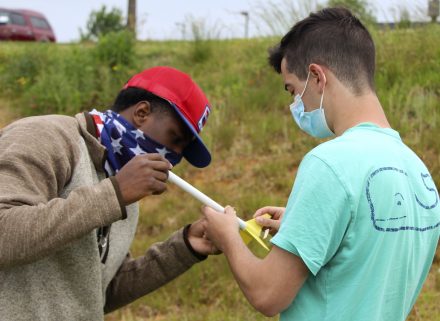About 15 model rockets soared over Elon's campus in project capping EGR 123: Grand Challenges in Engineering II
Controller in hand, Andrew Weitz ’23 placed his 3D-printed model rocket on the launch pad Tuesday, backed away and nodded determinedly. It was now or never.

He and partner Lamar Williams ’24 spent the weekend redesigning their rocket after a troublesome first test the week before. Their earlier design didn’t perform as planned, hurtling both the rocket and launch pad across the grass on a south campus field. Tuesday’s rocket employed thicker fins, a shorter nose cone, smaller diameter and a stronger launch lug — a ring that holds the projectile to the launch pad but must be loose enough to allow it to fly.
Weitz gave the thumbs up to Williams on the field — armed with tools for measuring the rocket’s height and distance traveled — and hit the ignition. First a flickering sputter, then a “whoosh” as their model shot into the sky.

Classmates gave a collective “Whoa!” as the foot-long projectile raced high and landed in the field behind Williams. It travelled more than 150 feet into the air and landed a distance of 175 feet from the pad.
“That was a success. I think yours flew higher than any team’s this semester,” Associate Professor Sirena Hargrove-Leak said.
Weitz and Williams weren’t alone in a troublesome first launch. Other teams’ designs had issues with takeoff, flight trajectory and the deployment of a parachute for landing. Between Hargrove-Leak’s and Engineering Lab Manager Matthew Banks’ EGR 123: Grand Challenges in Engineering II classes, about 15 rockets were tested this week. After weeks of computer-assisted design and simulations, some students were understandably a disappointed with the debuts of their semester-capping projects.
“The beautiful thing about engineering is that if it doesn’t work right the first time, you can do it again,” Hargrove-Leak told them. “And so, if you’d like, you will have the opportunity to redesign and try again next Tuesday.”
In a culture of perfectionism, Hargrove-Leak wants Elon’s engineers to find value in imperfect experiences. Rarely does the first design or prototype end up being the final product. Failure is the key to success, and the ability to test, assess, and improve designs without discouragement are skills cultivated by strong engineers. Each team will submit a report detailing their designs, improvements, results, and plans to improve future iterations as the spring semester ends.

Hargrove-Leak’s spring course is one of several foundational engineering courses that explore the National Academy of Engineering’s 14 Grand Challenges for the 21st Century. Those various challenges include designing the tools of scientific exploration, improving health analytics and care, and access to clean water. At Elon, experience with those challenges is blended with a broad overview of engineering ethics, practices, and learning the tools of design. Elon’s mission is to produce engineers who incorporate broad thinking in the liberal sciences and whose ambitions to improve the quality of life aren’t curbed by unavoidable setbacks.

The design process is also fun, apparent in the smiles and laughs as first launches didn’t quite go as planned.
Henry Agyemang ’23, Rane Parr ’24, and Arianna Sakoutis ’24 encircled the cracked remnants of their rocket to sing a few lines of “Amazing Grace” and retire it in a mock funeral. It held together through a first launch and rough landing Thursday when its parachute didn’t deploy but broke apart in the second launch Tuesday.
“We think the glue was probably weakened,” Sakoutis said. “Both our flights had some issues, but when you put them both together that makes for one successful flight,” she cheerfully added.
That’s the spirit.




